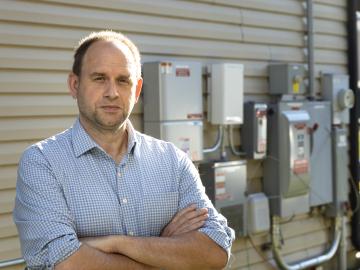
Filter News
Area of Research
- Advanced Manufacturing (3)
- Biology and Environment (28)
- Computational Engineering (1)
- Computer Science (2)
- Electricity and Smart Grid (1)
- Energy Science (62)
- Energy Sciences (1)
- Functional Materials for Energy (2)
- Fusion and Fission (6)
- Fusion Energy (7)
- Isotopes (16)
- Materials (28)
- Materials for Computing (3)
- Mathematics (1)
- National Security (10)
- Neutron Science (8)
- Nuclear Science and Technology (10)
- Nuclear Systems Modeling, Simulation and Validation (1)
- Quantum information Science (4)
- Supercomputing (20)
News Type
News Topics
- (-) Advanced Reactors (20)
- (-) Clean Water (21)
- (-) Cybersecurity (15)
- (-) Energy Storage (63)
- (-) Frontier (13)
- (-) Isotopes (28)
- (-) Quantum Science (23)
- (-) Space Exploration (11)
- 3-D Printing/Advanced Manufacturing (70)
- Artificial Intelligence (42)
- Big Data (38)
- Bioenergy (49)
- Biology (58)
- Biomedical (31)
- Biotechnology (13)
- Buildings (41)
- Chemical Sciences (39)
- Composites (19)
- Computer Science (84)
- Coronavirus (21)
- Critical Materials (15)
- Emergency (2)
- Environment (107)
- Exascale Computing (14)
- Fossil Energy (1)
- Fusion (28)
- Grid (35)
- High-Performance Computing (44)
- Hydropower (8)
- Irradiation (3)
- ITER (6)
- Machine Learning (29)
- Materials (79)
- Materials Science (69)
- Mathematics (8)
- Mercury (7)
- Microscopy (32)
- Molten Salt (6)
- Nanotechnology (31)
- National Security (30)
- Neutron Science (52)
- Nuclear Energy (52)
- Partnerships (13)
- Physics (27)
- Polymers (20)
- Quantum Computing (10)
- Security (11)
- Simulation (24)
- Software (1)
- Statistics (1)
- Summit (13)
- Transportation (64)
Media Contacts

A developing method to gauge the occurrence of a nuclear reactor anomaly has the potential to save millions of dollars.

Two staff members at the Department of Energy’s Oak Ridge National Laboratory have received prestigious HENAAC and Luminary Awards from Great Minds in STEM, a nonprofit organization that focuses on promoting STEM careers in underserved

Oak Ridge National Laboratory scientists evaluating northern peatland responses to environmental change recorded extraordinary fine-root growth with increasing temperatures, indicating that this previously hidden belowground mechanism may play an important role in how carbon-rich peatlands respond to warming.

Combining expertise in physics, applied math and computing, Oak Ridge National Laboratory scientists are expanding the possibilities for simulating electromagnetic fields that underpin phenomena in materials design and telecommunications.

Joe Hagerman, ORNL research lead for buildings integration and controls, understands the impact building technology innovations can have during times of crisis. Over a decade ago, he found himself in the middle of one of the most devastating natural disasters of the century, Hurricane Katrina.

Researchers at Oak Ridge National Laboratory developed a method that uses machine learning to predict seasonal fire risk in Africa, where half of the world’s wildfire-related carbon emissions originate.

Oak Ridge National Laboratory scientists seeking the source of charge loss in lithium-ion batteries demonstrated that coupling a thin-film cathode with a solid electrolyte is a rapid way to determine the root cause.

The Department of Energy’s Office of Science has selected three Oak Ridge National Laboratory scientists for Early Career Research Program awards.

Giri Prakash, data informatics scientist and director of the Department of Energy’s Atmospheric Radiation Measurement Data Center at Oak Ridge National Laboratory, has accepted an invitation from the National Academies of Sciences, Engineering, and Medicine to serve a four-year term on the U.S. National Committee for CODATA.

Matthew R. Ryder, a researcher at the Department of Energy’s Oak Ridge National Laboratory, has been named the 2020 Foresight Fellow in Molecular-Scale Engineering.


